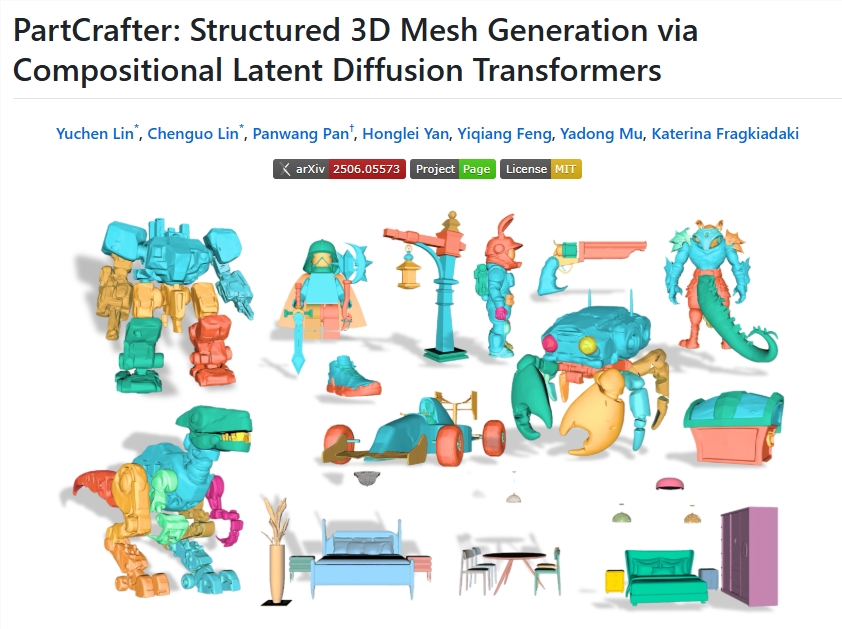The 3D modeling landscape is set to undergo a seismic shift with the unveiling of PartCrafter, a groundbreaking project developed collaboratively by Peking University, ByteDance, and Carnegie Mellon University. This innovative technology has the potential to upend the traditional complex process of "segmentation followed by reconstruction" by generating high-precision, structured 3D models from a single RGB image.

PartCrafter stands apart as a pioneering model in structured 3D generation, capable of directly generating 3D models with multiple semantic components from a single RGB image, achieving end-to-end generation. It diverges from conventional methods that necessitate segmentation before reconstruction, opting for a unified generative architecture that outputs complete 3D scenes without pre-segmentation. This feature endows PartCrafter with exceptional performance in handling both single objects and complex multi-object scenarios.
At the heart of PartCrafter's innovation lies the combination of a composite latent space and a hierarchical attention mechanism. The composite latent space assigns a unique set of latent tokens to each 3D component, ensuring semantic clarity and editing flexibility between parts. The hierarchical attention mechanism processes information flows both within and between components, maintaining high coordination in local details and global consistency of the generated 3D models.
One of PartCrafter's most impressive capabilities is its "perspective" ability, which allows the model to infer and generate complete 3D geometric structures even when certain components are occluded in the input image. This is made possible by its foundation in a pre-trained 3D mesh diffusion Transformer (DiT), inheriting generative capabilities from large-scale 3D datasets and further optimized through innovative architectural design.
PartCrafter's technological breakthrough transcends the traditional two-stage method, which is not only inefficient but also prone to errors from segmentation. By eliminating the dependency on pre-segmentation, PartCrafter achieves dual breakthroughs in generation quality and computational efficiency. It can generate structured 3D models from a single image in approximately 40 seconds, significantly outperforming traditional methods.
Experimental results indicate that PartCrafter has achieved State-of-the-Art (SOTA) effects in structured 3D generation tasks, even surpassing the fidelity of its underlying 3D generation model in object reconstruction. This demonstrates that understanding the composite structure of objects can significantly enhance the overall quality of 3D generation, offering new insights for future 3D modeling.
To support component-level generation, the PartCrafter team has meticulously constructed a large-scale dataset containing 130,000 3D objects, with 100,000 objects having multi-component annotations. This dataset integrates well-known 3D resource libraries such as Objaverse, ShapeNet, and ABO, providing rich supervisory information for model training through component-level annotations. The release of this dataset is expected to provide valuable resources for research in the 3D generation field, enabling more teams to explore the potential of structured modeling.
The release of PartCrafter signifies a new phase in 3D modeling technology. Its end-to-end generation capabilities and the ability to handle complex scenes make it highly applicable in fields such as game development, virtual reality, industrial design, and digital twins. Not only can PartCrafter generate decomposable 3D meshes, but it also supports flexible component editing, providing creators with greater freedom.
Developers have responded enthusiastically to PartCrafter's innovative design on social media, praising its "simple yet effective" approach to redefining the paradigm of 3D generation. The project team has announced that the code, pre-trained models, and Hugging Face demonstration version will be released soon, further lowering the technical barriers and empowering developers worldwide.
Looking ahead, PartCrafter's emergence is not just a technological breakthrough but also a profound enabler for the 3D content creation ecosystem. With the open-sourcing and further optimization of PartCrafter, 3D modeling is expected to become more intelligent and widespread. In the future, this technology may extend to real-time 3D generation, dynamic scene modeling, and even multimodal inputs, bringing more possibilities to fields such as the metaverse, robotic vision, and intelligent manufacturing.